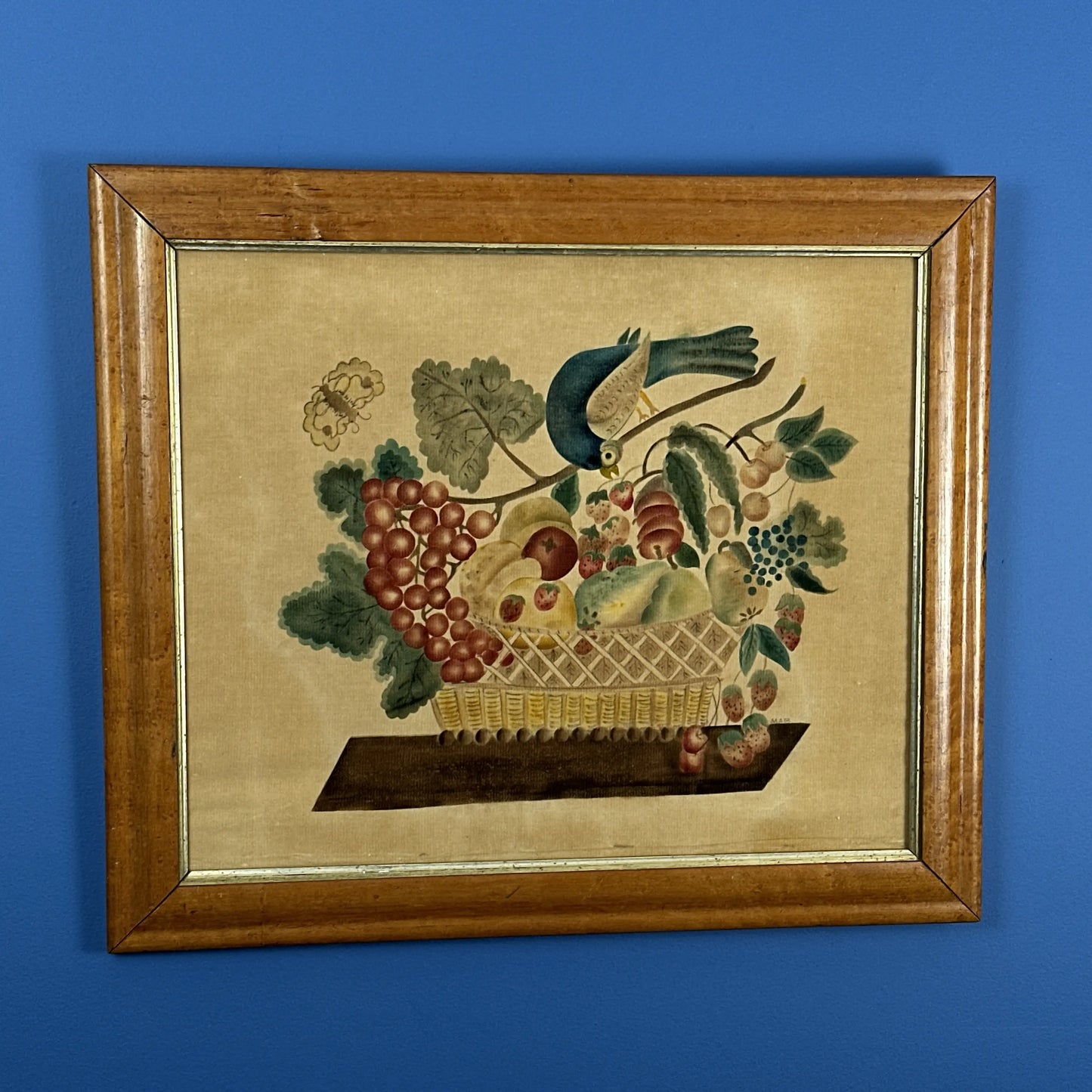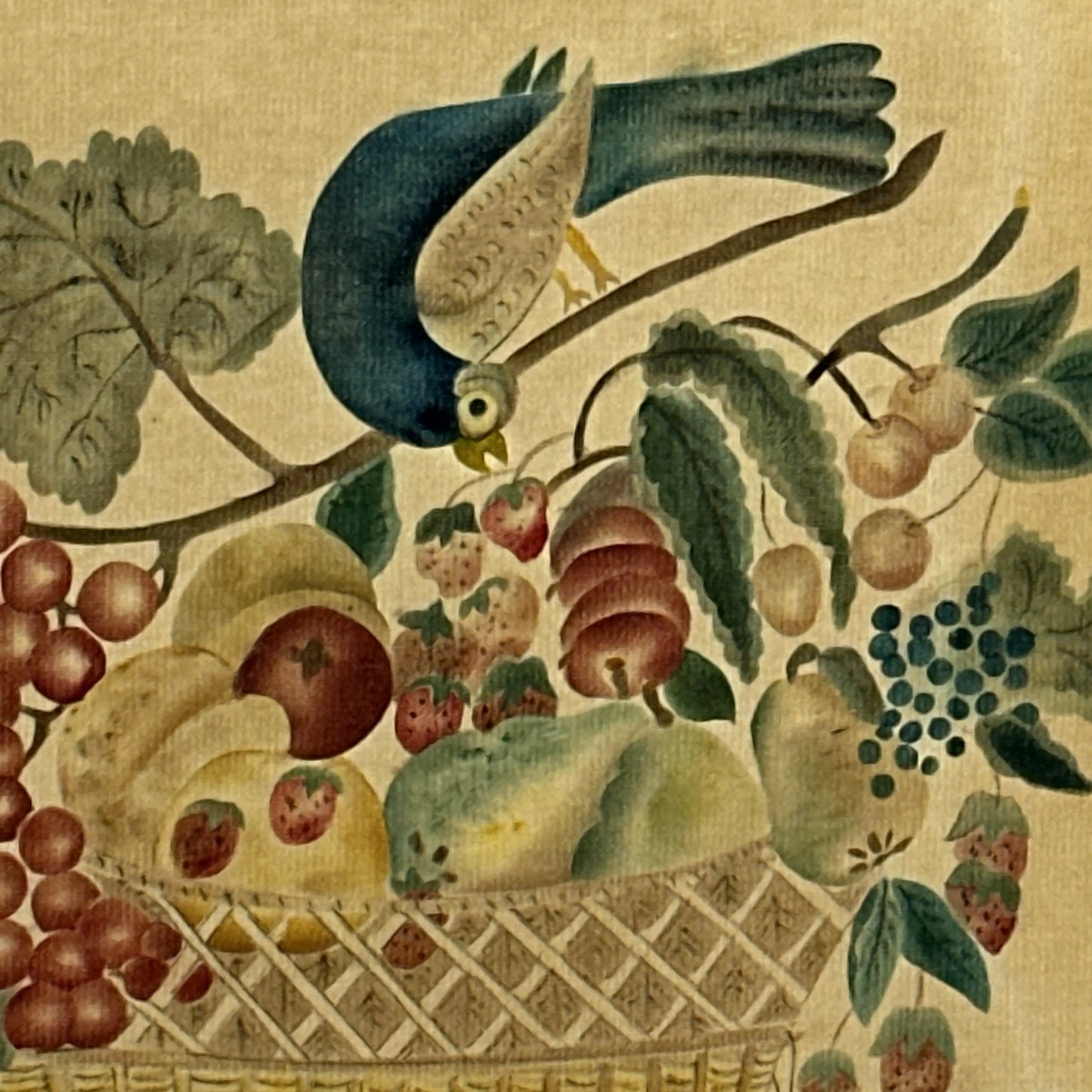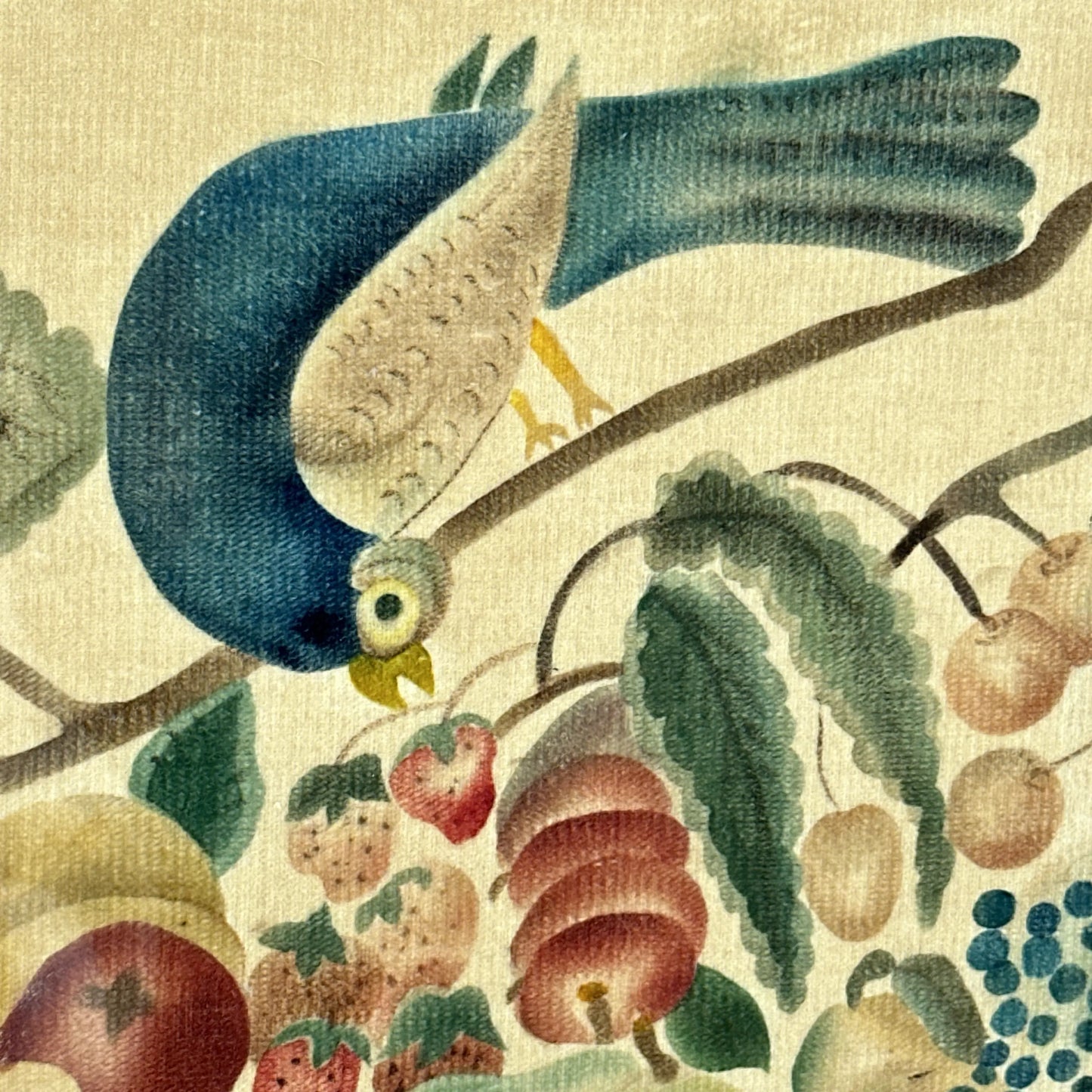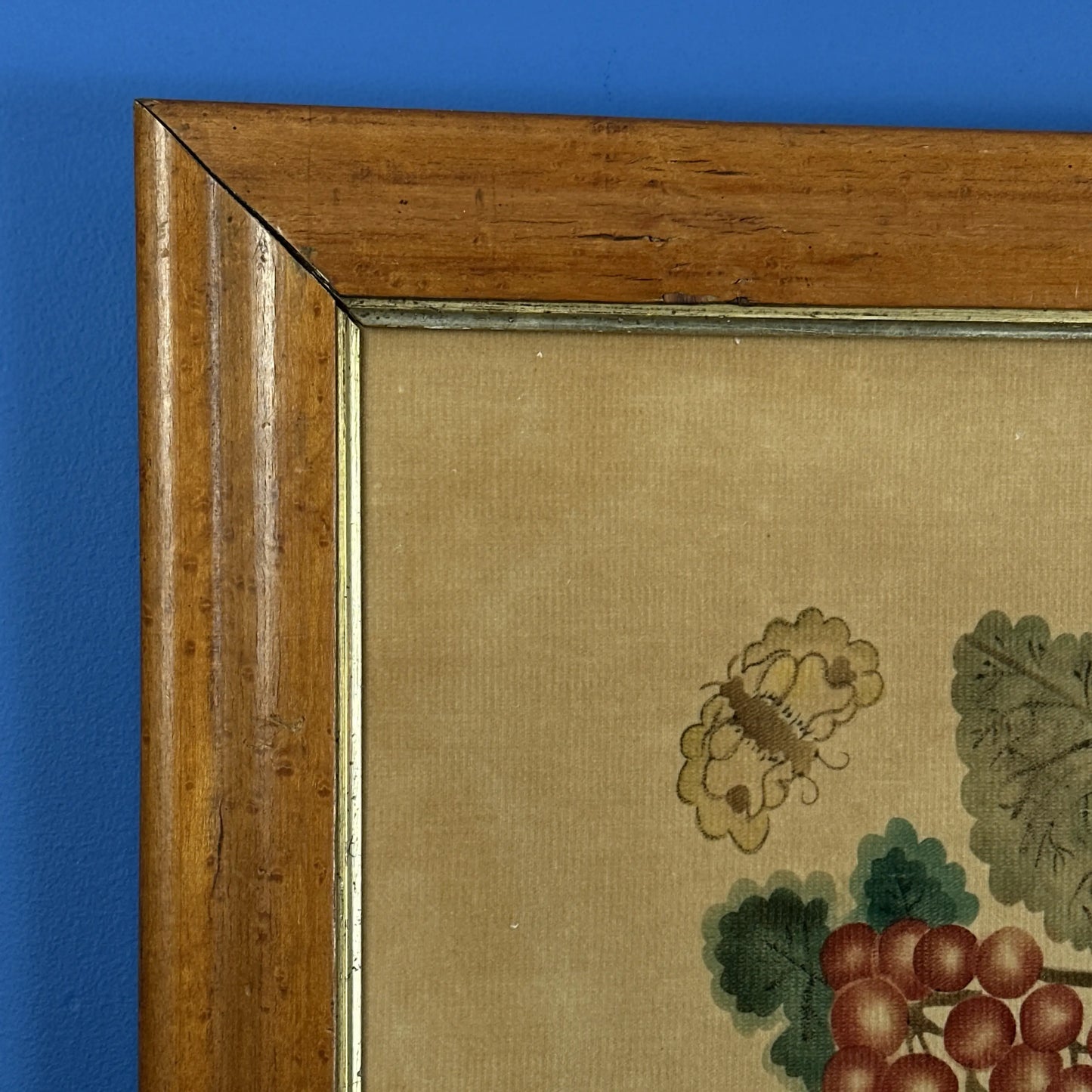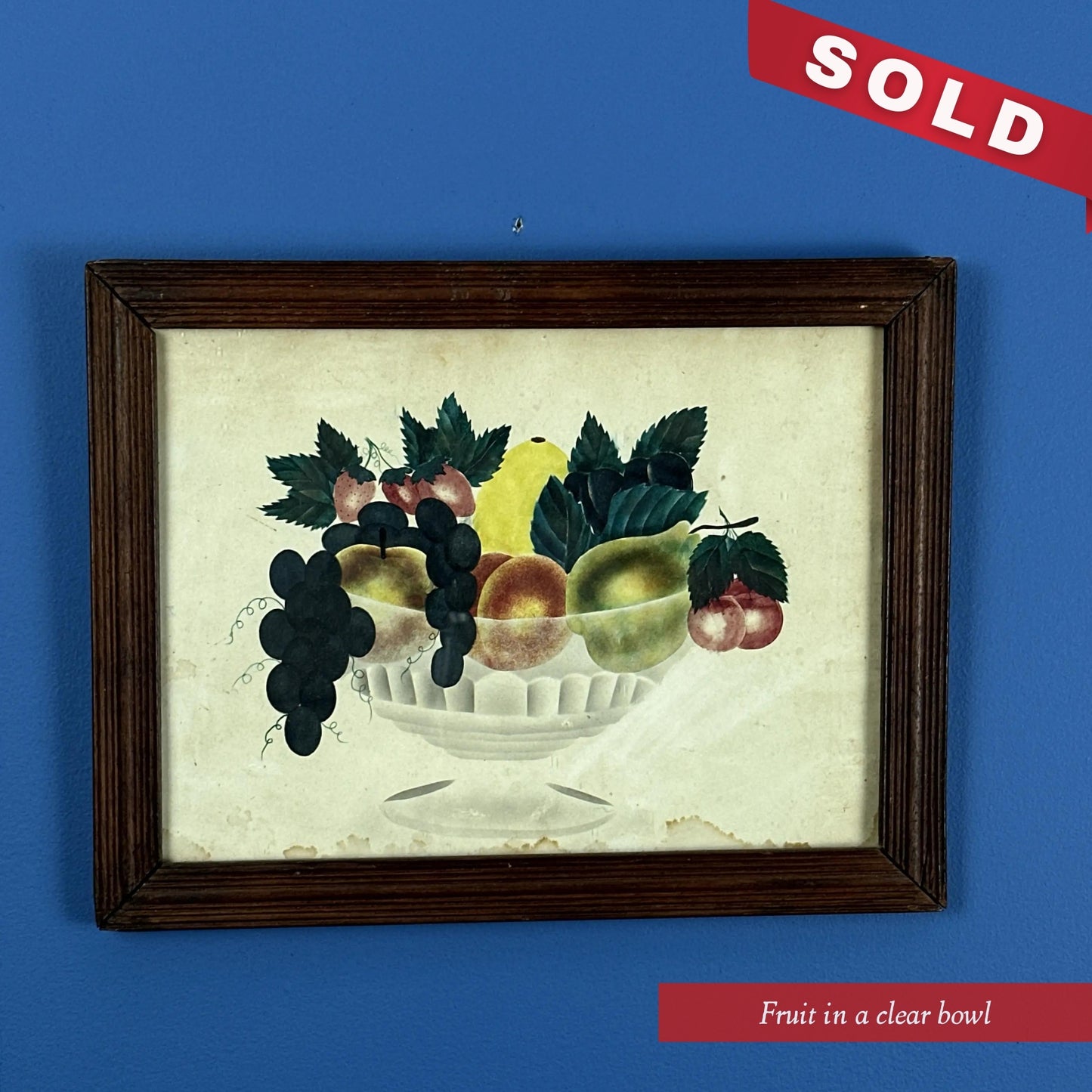The History List
Folk art paintings — Theorems
Couldn't load pickup availability
Updated at 9:15 pm: The small painting has been sold. The large one is available.
Two "theorems," folk art painting popular in the early 1800s.
Sold: Fruit in a clear bowl, on paper in a simple wood frame. As can be shown in the picture, there is some light water staining along the bottom. Size framed: 10" x 12.75".
Available: Fruit in a basket with bird and butterfly. On fabric. Framed in a birdseye maple frame. As shown in the picture, just to the right of the upper left hand there is some swelling of the frame. It's noticeable if you're very close to, but it's doesn't stand out at the typical viewing distance.
I don't know the ages of these. As explained below, this folk art originally dyed out in the 1840s. While there was a later revival around the bicentennial, the small "seeds" in this glass indicate that these are not modern pieces.
Along those line, since I didn't replace the antique glass, you'll want to keep these out of direct sunlight.
The small one is very inexpensive; the larger one reflects the size, the quality of the image, and the beautiful frame.
— Lee Wright | Founder
Shipping: $10.
Historical background
Theorem paintings, which became popular in the early 19th century, began with the cutting of stencils into various shapes. Usually fruit and leaves were used, however rare examples have been discovered using bird shapes. A good example of what stenciled designs look like are antique Hitchcock chairs.
The first step was deciding what the main subject, such as a bowl of fruit, would be and the background material, usually velvet. The stencils were placed in various positions and filled in, with oil paints. 19th century theorem painters traced a design on transparent paper, cutting out the pattern and creating a stencil.
Stencil paintings old and new come to auction and prices can sometimes be competitive.
Antique theorems can turn up anywhere from barns to garage sales. In the 19th century theorem painting on velvet became a popular pastime for women around the country. It was a painstaking process as each stencil was placed on the velvet and held firmly in place with tacks or weights as each was painted with oil paints. The more skilled artists were able to create shading. . . .
Theorems were also done on paper, cotton and silk. Some were made into pincushions and purses and given as gifts.
Often itinerant artists traveled town to town decorating floors, walls and wall screens with stenciled designs. Theorem painting went out of fashion by the 1840s. . . . Theorems can sometimes be dated by the style of the glass container or basket holding the fruit and flowers. For example, pressed glass compotes, often used in theorems weren’t made before the 1830s.
Source: Mountain States Collector
Shipping
Shipping
For shipments to addresses within the U.S. (scroll down for International shipping)
Flat-rate shipping: Regardless of the number of items you order, the shipping price for shirts, caps, unframed prints and posters, bracelets, lapel pins, pendants, and button packs is $5.95.
For hooded and crewneck sweatshirts, mugs, and blankets, the shipping cost is $8.95.
Our flat rate shipping means you can add two or more t-shirts, sweatshirts, or caps for no additional shipping charge.
Note that some large or heavy items, including larger framed prints, may have a different shipping charge or a shipping surcharge. When they do, it will be noted on the product page.
Timing
We try to ship orders within three business days of receiving them. This applies to in-stock items. Framed items or items requiring personalization may take up to two weeks longer. If there is an extended delay, it will be noted on the product page.
We close for a week over Independence Day and Christmas. A notice will appear at the top of every page of the site in advance of this closure.
We ship most orders via USPS, so if the post office is closed, we won't be shipping orders that day.
If you need to receive your order by a certain date, such as to give as a gift or have for a trip, we recommend ordering at least two weeks in advance, especially if you are using USPS shipping.
If you're looking for reliable, on-time deliveries, we strongly suggest upgrading to "UPS 3 Business Day Select Shipping."
Additional notes:
- When fulfillment takes longer, such as around the Christmas holidays, we'll put up an announcement in the site and will list recommended shipping deadlines below.
- If an item is out of stock, we will contact you.
- If one of your items is an advance order, that will be noted on the product page along with an estimate of when it will ship. If that estimated date changes, the product page will be updated.
Charges for shipping to destinations in the United States and to APO, DPO, and FPO addresses
- Free shipping
- On stickers, magnets, decals, patches, static clings, and individual button pins.
-
US Postal Service shipping - The least expensive, though also less reliable than UPS. (See more on UPS in the next section.)
-
$5.95 for shirts, caps, unframed prints and posters, bracelets, lapel pins, pendants, button packs.
Regardless of the number of items you order, the shipping price is still fixed at $5.95. Our flat rate shipping means you can add another t-shirt, cap, or book for no additional shipping charge.
-
$8.95 for hooded and crewneck sweatshirts, mugs, and blankets.
UPS 3 Business Day Select
Note: UPS 3 Business Day select is not available for addresses in Hawaii and Alaska. If UPS is selected for Hawaii or Alaska, the order will be shipped UPS Ground.
- $14.95 for shirts, caps, unframed prints and posters, bracelets, lapel pins, pendants, button packs.
-
$18.95 for hooded and crewneck sweatshirts, mugs, and blankets.
- If the actual shipping cost is significantly higher than what we’re charging, we will contact you to discuss alternatives.
- UPS Overnight (Next Business Day Delivery)
For shipments to addresses outside the United States
DestinationsWe only ship to locations that are served by US Postal Service International Service.
Charges
- Canada and Mexico
- $18.00 for shirts, caps, unframed prints and posters, bracelets, lapel pins, pendants, button packs.
-
$24.00 for hooded and crewneck sweatshirts, mugs, and blankets.
- Rest of the World
- Rates starts at $65.00.
Additional charges for all destinations
Some large, heavy items may have an additional shipping charge. If that's the case, it will be noted on the product page.
If the actual shipping cost is significantly higher than what we’re charging, we will contact you to discuss alternatives.
All original designs are copyrighted by The History List
All original designs are copyrighted by The History List
All designs are copyrighted by The History List and the History Nerd text and design on t-shirts is a registered trademark. If you see a knock off, please let me know.
Mission
Mission
Your purchases support our mission to engage people with local history and to support historic sites and history organizations across the country.
